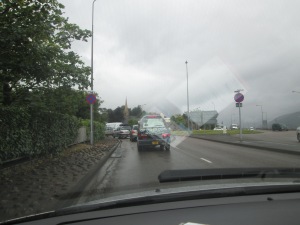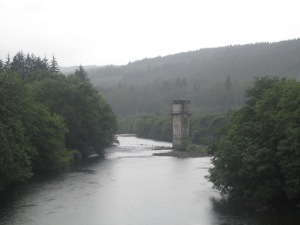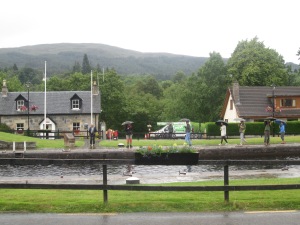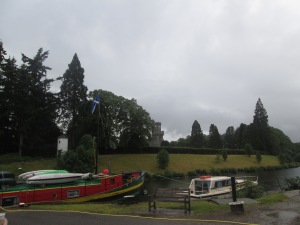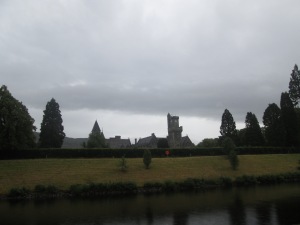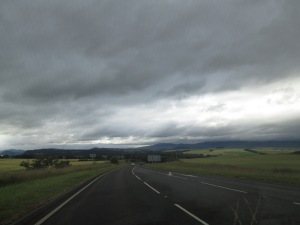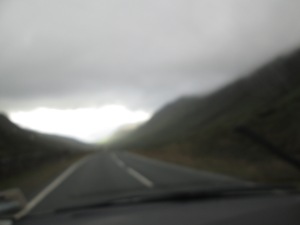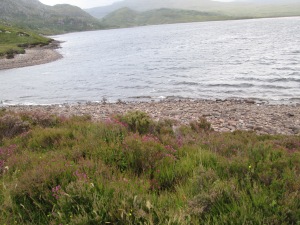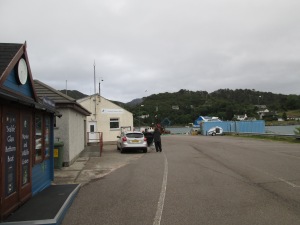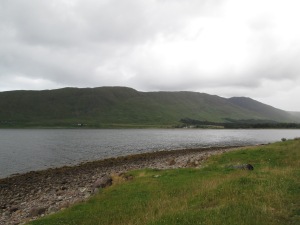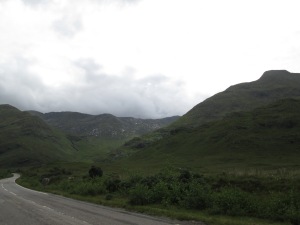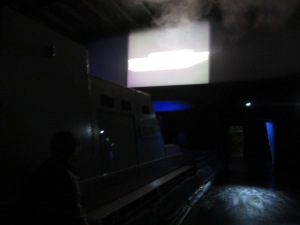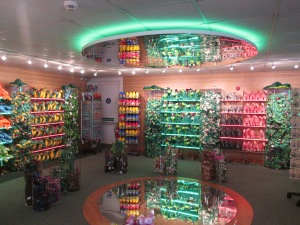‘Life doesn’t give you a user manual’ – Christy, Fort William.
Christy and I awake refreshed in our chintzy bed and breakfast on the shores of Fort William. The hotel’s a dive, and we’re both restless to escape out of the town in some way. But with a sprained ankle, Christy’s not able to ride any bicycle. Walking will only get us so far, and we’ve drunkenly lost ourselves in the wilds of Glen Nevis a previous night. The rain is still insisting on its responsibility to soak we weary humans to the skin, and fierce winds are affecting nearby boats.
Over a Scotch breakfast (like a full English, but with potato scones, black pudding and Irn Bru…) we decide to hire a car. It’s the one way of leaving the town and exploring and, besides, it can cheekily double-up as a cheap place to sleep. With that plan, we phone around til we find a cheap enough car on the outskirts of Fort Bill. It’s strangely exciting. Forget those steep mountains and hills, forget the bloody awful weather… none of these can restrict our striving to explore these landscapes. With the most basic of plans to head north, we decide to get lost on a spectacular level, to find and immerse ourselves in some rocky and remote wilderness. With provisions packed, we head out onto the open road.
Whoosh! It’s a brand new car and my driver handles it with some speed. It takes getting used to. Twenty miles, the subject of two to three hours’ meditative cycling and day-dreaming, expires in equivalent minutes. But it’s an opportunity to test how these landscapes feel at different speeds. Much of the north-west Highlands seemed like it would be as beautiful in a car. There’s a vicarious pleasure in reading about another’s travails and toils breaking their bicycles up the steepest of hills and most remote of midgey crannies. Surely in a car it’ll be much easier?
We pass Spean Bridge and Loch Lochy to our left, and drive through the village of Invergarry to reach Fort Augustus, a pretty village by the banks of Loch Ness and the Clyde Canal. Rain sluices down the roads, clagging gutters filled with tree debris. We squeeze between tourist coaches then venture out.
It’s hard to explain what makes a Victorian canal lock pretty, but there’s something about them that draws people and passers-by towards their grubby waters. We too take a peak, passing the remains of an old look-out tower and a smattering of tourist tea rooms and houses. The canal itself, a feat of nature improved by engineer Thomas Telford, is unusually wide, and there are sailing boats bobbing up between the locks. A homely-looking boozer sits next to a butcher specialising in haggis and the general quality of its meats. Christy sends up my insistent photo-taking with the most baffling and grave of poses.
We pop in to D.J. MacDougall and Christy gets some haggis and coffee. As he smacks his lips in delight, we drift out, passing more curious little local exhibitions, a war memorial hall and a craft store in a shack that much resembles a backwater church in remotest Louisiana. At the other end of Fort Augustus is Loch Ness itself as its southern point. The bay opens up from nowhere, its remarkable and piercing white light dazzling us even on such a misty and dank day.
Rain is falling hard and my shoes and socks are soaked. Continually waterlogged feet has started to cause a kind of trench foot condition that I’m struggling to manage. We drive on, keeping the vast Loch Ness to our right. The road is tight and fast, and the cyclists that cars skitter by remind me of my vulnerability on these trails. But there’s much that I miss.
The car is so smooth that at times one could be gently flying over its surface. It travels too fast to notice or recall how the scenery transforms, of where forests in valleys become the start of rugged mountain ranges. One loch could be another. Its speed means that with windows open, the wind prevents hearing the scapes. One can’t smell them, and the windshield could easily be some kind of elaborate film screen. Feeling cold? Turn up the heat. Is the route becoming dull? Switch on the radio. And that steep mountain in the distance that, by bike, would take an hour of intense physical and mental effort? We just drove over it.
Cycling is so much different. Continually exposed and immersed to the terrain, continually in tune with its transitions from hill to forest, moor to mountain, ever-immersed in its colours and smells, accompanied by the distant wail of the wind.
We pass road signs for Skye and various tourist traps along the Ness road in the villages of Invermoriston and Drumnadrochit. We reach Inverness a little before five, and take a trawl through its grand shopping precinct, largely defined by Victorian sandstone stores and a large covered market. Doubtless to say, much of it today is composed of bland chain stores, poundshops and fast food joints. I pop into Shoezone and find a pair of leatherette fake converse trainers for an insane eleven quid. Made no doubt in the most miserable of Dhaka sweapshops, their name is Beckett and it is suitably apt.
‘There is man in his entirety, blaming his shoe when his foot is guilty.’
Carrying them outside, two local lasses spy them and convey their approval. One can dress fashionably and cheaply here, and still do right by Samuel Beckett.
We wander back to a bland retail park of discount homeware and food shops, next to an ugly large car-park, and manage to locate the rental car. Off we head, driving along the same north-westerly roads out of Inverness that I rode some weeks ago, but in a fraction of the time. We whizz over the North Kessock bridge and over the A9, roaring along the ugly dual carriageway that nearly broke me on the way to Wick. We take the smaller road to Ullapool. At last, the traffic starts to reduce and the terrain gets wilder and far more fascinating thereafter.
The route is rugged and beguiling. Forests flank our sides, Strathgarve and Garbat, The road soars up into the mountains. We forget to breathe as we take in the extraordinary views. To our right we’re flanked by lovely Loch Garve. The scenes are too enchanting to consider checking a map.
Eventually we stop by one small inlet of water in the Dirrie More mountain pass to explore the place a little on foot. In the distance is the ruined remains of a farm shack. On this hillside untroubled by other traffic, cotton grass and a kind of samphire grows freely. Great billows of froth have been washed in by the sea. Both of us stop for a moment to listen to the absence of human noise, just the gentle rustle and whistle of the wind.
Further north-west is Gairloch, a small harbour village with a scattering of boarded-up kiosks offering whale rides. Boards evidence the sheer abundance of wildlife spotted here, from sea eagles to minke whales and seals. We poke about the fishing pier and inspect the boats, but the village is pretty deserted. It’s a shame, as the village is ripe with curios, like its tiny radio station. There’s something equally magical about the area here, its unusually rich light and the quality of its climate. Even its local clan leaders, the MacKenzies, refused to evict a single tenant during the 19th century when the clearances were raging elsewhere. Their estate ran at a loss, and they welcomed evicted Highlanders from other parts. Scotland’s rugged beauty and warmth is coming closer.
A road passed earlier pointed to Shieldaig, and we return back curious. Theoretically it should lead to another remote section of the western coastline, but having no map or phone reception, it’s a bit of a punt. It takes us along a rocky single track trail past the Shieldaig lodge and to Badachro, a village so remote its final post collection is at 7.45AM (though I will find one place in two days’ time even more distant). Badachro fortunately has a perfectly located inn, overlooking Gair Loch. We pop in to refresh ourselves and take a break. The place specialises in fresh seafood, but the mariner miscellanies on the walls and cosy ambience of the place are more than amenable for drinking.
Over an ordinance map and some Hector beer by An Teallach we pore over our road. We’re in the inner recess of nowhere and it is quite wonderful. A huge mountain range fills the map to the south, and the small road we’ve followed simply fizzles out into a dead end after Port Henderson. Evening is closing in, and Christy’s quite fairly tired out from all the driving. Further south is a second Shieldaig and the even more remote mountains around Applecross.
The car backtracks along the same road, but we detour west and drive over the epic Mount Torridon. Herds of red deer occupy the road, then flee when we come approach. The mountain vistas are quite extraordinary.
Strange that there are two Shieldaigs on this western stretch. We suspect that someone got lot finding one and, in confused desperation, decided to christen their new abode Shieldaig, fearing the former had been razed by Vikings, land-clearers or the arbitrary will of a god. We approach the second Shieldaig and finish the day’s explorations with a night cap of beer and Bunnahabhain. The locals stare down into their drinks and chide a suffering young barmaid, and tired out, Christy and I have little to say to each other, our minds preoccupied with the feast of views of loch, glen and distant mountain we’ve found along the north-west Highlands. This route into the remote would take about a week on the bicycle, but by car, around eight hours.
Sleepy and a little drunk, the front car seats are reclined back and make for a more comfortable bed than most nights in my tent. Parked cheekily adjacent to a local B&B, we whisper to each other a while as we once did as kids in our bunk beds, before gently dozing off.
The windshield is entirely fogged up in the morning, effectively concealing a sleeping pair from any morning strollers. Where to today?
South is the Applecross peninsula, a stretch of small settlements in one of the most remote corners of Scotland. Until the early 20th century, the primary settlement of Applecross, ‘the Street’, could only be reached by boat. A road of sorts was built laterally over the steep mountains but remains one of the toughest roads to drive, a twisting single-track affair with eye-wateringly steep moments. The Bealach na Ba, or ‘pass of the Cattle’, is enticing.
The drive takes us further and further into a place that feels as remote and empty as it does peaceful and tranquil. The Gaelic name for Applecross is a’ Chromraich, ‘the sanctuary’. We meet one man rebuilding a wall in a hamlet we pass and take a wander in. He used to work as a chef in Michelin star restaurants in London, he tells us.
‘I started coming here, just for a break, you know. Then I was coming here four or five times a year. There’s something about the place. Eventually, I thought, you know what, I’m gonna go for it, I’m so much happier here. Have you been to Applecross yet?’
‘No, that’s further south, right?’
‘You’ll love it. I’ve never regretted it. I just couldn’t go back.’
He’s quite right. We drive down into a wide bay, and pop into a walled garden that adjoins a restaurant. Everything is alive, ripe and in bloom. Further down is the Street, the village known as Applecross. There’s a pub and a car-park, tourists congregating around the gorgeous sea sights, and German bikers sipping on cappuccinos. We drive along the gnarled and twisty roads, following one trail to a dead end in the midst of distant peaks, then another that ends in an islet full of sheep who refused to budge. We’re totally lost.
Some directions through the window of a cottage eventually point us back to Applecross and towards the narrowest of road passes. This is the pass of the cattle and, true enough, it’s as treacherous as it sounds. The local lady peers at a car and gives a few moments’ consideration before judging the car just about suitable for the task ahead.
We breakfast on chips to steady ourselves. For me the task is quite easy, and I’m glad not to be one of the handful of very fit looking cyclists we pass abusing themselves by attempting to cross the terrain. Driving lessons in south London don’t quite prepare you for the narrow tracks and hairpin twists ahead though, but through some skill we reach the top.
There’s a small parking area to stop in. In the distance, Raasay, Skye and more distant Hebridean isles lie yonder. At such heights every aspect of one’s reality feels distant and, in its own way, not so important. For a moment, the superficial packaging and transient fixations of the self are forgotten, they fall away like a character in a film that has come to an end. Sea, earth and air each matter, but not so much that one feels even grounded. Outstretch the limbs of your mind and picture taking flight. It’s that kind of freedom.
The descent down Applecross is far more tricky than the rise, and driver and navigator begin to bicker and fall out over methods. It’s probably the hardest driving I’ve seen, and were I behind the wheel, the vehicle would have no doubt disappeared down some verge and into the abysses of Wester Ross. Fortunately my brother steers us to safety, and we drive down through Lochcarron, and through a mountain tunnel with the intriguing appeal to
‘Dread god and do well’.
It’s the archaic motto of Ross and Cromarty county, the stuff of a fairytale library book about a distant and remote mythic land of clans, giants, killer critters and tranquil founts of inner peace. We drift on, the roads becoming flatter for a time. We drive by Eilean Donan castle, then sweep under the heights of the Five Sisters. A little gorged on nature’s majesty, Christy suggests with a tongue in cheek that we check the Loch Ness Visitor Centre in search of Nessie.
It’s a short ride back to Drumnadrochit, the worst of the Nessie tourist villages – though, to be fair, quite pretty. The visitor centre itself is as hilarious as you’d expect. There is no pretence at being a museum or remotely factual. One enters and queues for an attraction that works like a theme park’s ghost house: one must enter a string of rooms. In each is a screen with some flashing spooky lights and sounds that introduces and tells the story of sightings of strange beasts on the Loch.
Early on it’s clear that sightings were sensationalised and then fabricated for a brief period around 1933. Tricks of the light from the wash of vessels to birds and movements of small fish can each contribute to something looking like the monster, but the video testimonies of old locals collected in the 1970s are awfully gullible. A prior story of a possible monster could have only led them to think their confused deceptions substantiated credible testimony. What’s more mysterious is that so many intelligent people have spent decades observing the loch with telescopes and progressively sophisticated equipment. But each room continues in this vein until it ends in a huge gift shop of a similar size to the ‘museum’ itself. Cuddly toys and kids’ aprons and toys jostle against tourist tees, tartan crap and other tosh. This is the most significant room in the collection and reveals the true secret of Nessie.
Laughing our heads off, we jump back into the car and head through Inverness again for some diesel before driving out east. Content with our wanderings in the west, we agree east as a base direction. The Highlands are split by the Great Glen fault, a line between two different tectonic movements east and west. The line passes through Loch Ness and the modern Caledonian canal largely follows it. Yesterday we’d inadvertently explored the western side of the Great Glen. We decide to complete the circle.
The road takes us back towards the Caingorms, that most lovely of cycle passes. The speed of the drive allows some broader comparisons to be made. After the dramatic and jagged sights of the north-west, the Cairngorms and Grampians by contrast are far more gentle, expansive and verdant. The scenery remains steeped in places and there are impressive heights here, but they arrive more gently, and one always feels on some kind of plateau surrounded by forest. Nothing interrupts this scenery with the same impatience or drama as the average mountain pass of the west. It’s quite extraordinary. We drive through Aviemore, a skiing town as tacky as warned, and head out quickly enough. There are small villages at Kingussie, Laggan and Dalwhinnie. In the evening sun we keep driving, listening to the radio or the wind as the mood takes us, tongues silent but minds alive with recording these majestic surroundings.
Evening is falling and we decide to call in at Pitlochry, a pretty tourist village not far from Perth. It has a couple of Scotlandland type stores excessively catering for tourists but it keeps itself in check and retains a sobriety and jollity missing from Aviemore. A small cul-de-sac on the edge of the village seems promising enough as a place to ‘wild-park’ (what else to call cheekily sleeping in a car?), and we head to the Old Mill Inn for some beers.
They have Christy’s favourite tipple on tap, Brewdog’s Punk IPA, and I treat him to a few pints as meagre repayment for the immense amount of driving he’s done, and the fun and warmth of his companionship. This hiatus outside our home city has been a blessing. I appeal to him to stay out longer, to cancel his return ticket and explore Scotland more, on his own, and perhaps find inspiration, solace and community in this landscape that our home has rarely provided. He’s unsure, rightly so.
From this distance, London seems like a sophisticated human farm, churning out people in processes that squeeze everything into the most economically ‘effective’ productivity. I recall the pressures around, the rising rents, bills and food prices, the struggles to squeeze onto public transport, the routine aggression and impatience that stands as civility in much of the city. When I use the term ‘abyss’ to describe some aspect of the north-western Highlands I mean it in quite a figurative way, in the absence of signs of any human colonisation, in its rich self-sufficiency.
But the London-Home Counties conurbation is the real abyss of society and life. It is a sorry victim of neoliberalism, that gamut of government policies to privatise industries and utilities, destroy trade union powers and membership, and re-establish economic growth on property speculation, wealth savings and financial trading. There are some wonderful parts, and some excellent instances of community under the surface in inner London – I know, I’ve worked in them, grown up in them, given up time for them. And I will write about them in due course.
But right now, after two days in the Highlands with your best mate and oldest companion, it’s hard to face it again. Any kind of collective political change has to tackle the London-Home Counties conurbation as its problem. No longer merely a ‘great wen’ or wart, as William Cobbett called the city, but a sprawling and festering cancer on the surrounding regions. Scottish independence is only one of countless struggles that suggest this to me.
Our trajectories will split again. He’s done a great kindness to me, joining me in these remote parts, and I’ve been glad in turn to share what I’ve found of Scotland. I have some months ahead of cycling and then a PhD in the most abstract of matters to complete. Its utility is increasingly dubious. The occasional pips of left-wing continental philosophy I stumble across on my travels seem like a kind of navel-gazing and autistic activity, now that I can compare them to the richer multiverses of community building and political discussion that take place without requiring a master’s degree to participate. These conversations happen every day, among people with a far greater range of life experiences and ways of life. And with far more humility and humour too. That’s needed, and that’s possible.
Has there been a time when the current establishment of politicians, bankers, press owners and police have been less trusted and less loathed? Consider the scandal of an impartial poll that measured public trust in these figures to impartially manage affairs. A generation of young people are growing up in a society where it’s an open fact that their lives will be shorter, less healthy, poorer and more wracked by preventable physical and mental diseases than their parents. The connections to an economy based on debt, speculation and unfair social inequality are bloody obvious.
As Ewan said on Eigg, there’s a possibility here. It wouldn’t take the form of anything that looks normally political, like a conventional political party seeking a vote, or a trade union official representing the shrinking rump of unionisable labour. It could take a more humourous, modest and positive approach to the first political right of all, that a society should be governed in the interests of all of its citizens, now and in the future. It could use plain language for a start. It might find its ideas not in the mysterious tomes of the dead, but in the stories and experiences of workplaces and communities, in person or online. Something needs to be broken.
He’ll return to London, back to signing on the dole and trying to work out what kind of life he can establish for himself that’s dignified, interesting and reasonably paid. At the end of school we were told to ‘go to college’, and at the end of college they told us ‘go to uni’. For many like Christy, that’s pretty unhelpful. Much of his adult life has been spent in low paid and unsatisfying jobs in the service sector or on the dole. I’ve followed the rules, gone to uni, worked ambitiously, but I can’t go to him and say it’s much better. The problems are much deeper. London won’t help him.
The road ahead is uncertain. We’re too tired to drink more than a few pints, though they serve Smokehead whisky here, my favourite of all. Dinner is found in a Co-op supermarket, bread and cheese, and just outside someone’s front drive, two lazy mid-twenty-somethings make a bed for the night.



